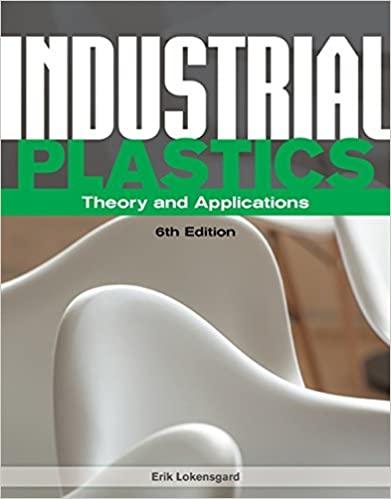Answered step by step
Verified Expert Solution
Question
1 Approved Answer
1 : Shelf Life of PET Bottles for Carbonated Beverage Packaging Applications [ 3 0 pt ] A PET bottle used for packaging carbonated beverages
: Shelf Life of PET Bottles for Carbonated Beverage Packaging Applications pt A PET bottle used for packaging carbonated beverages loses CO primarily by permeation through the walls, sorption in the walls, and leakage through an imperfect cap. Twoliter PET bottles have received rapid acceptance from bottlers and consumers for carbonated soft drinks. These bottles can have a shelf life of several months Shelf life is generally accepted as the time required for loss of CO from the bottle The surface areatovolume ratio for a liter and liter bottle is and higher than a liter bottle, respectively. Hence, to achieve desired shelf lives for these smaller volume bottles, an exterior barrier coating of a high barrier such as polyvinylidene chloride PVDC is applied to the bottle. The shelf life of a liter PET coke bottle is approximately weeks.
a Develop an algebraic model to predict the shelf life of a PET bottle with a uniform layer of a high barrier polymer on the outside of the bottle. ptb Calculate the thickness of a SaranPVDC copolymer barrier coating required to increase the shelf life to weeks. For the purposes of this calculation, please assume that the package operates at pseudosteady state. That is the time to establish a steady state concentration profile across the bottle wall is very rapid compared to the shelf life. Additionally, to simplify the calculation, please assume that the mass transfer area of the bottle can be modeled as a flat sheet of thickness mil mil micrometers and surface area of in pt
The average CO partial pressure difference across the bottle wall is atm and, for the purposes of this calculation, assume that this average partial pressure difference changes very little over the course of the package shelf life. The initial amount of CO inside the bottle is cmSTP The shelf life is reached when the amount of CO in the bottle decreases by cmSTP to cmSTP The permeability of CO in PET under typical operating conditions is cm mil in day atm and the permeability of CO in Saran is cm mil in day atm
In addition to permeation across the wall of the bottle, there is a steady loss of CO through the bottle cap, and the amount of this loss is cmSTPday Moreover, immediately after pressurizing the bottle with CO there is a very rapid loss ie an essentially instantaneous loss of CO due to sorption of CO in to the bottle wall, and the amount of this loss is cmSTP Finally, there is an effective instantaneous CO loss, immediately after pressurization, of cmSTP due to bottle expansion effects
Step by Step Solution
There are 3 Steps involved in it
Step: 1

Get Instant Access to Expert-Tailored Solutions
See step-by-step solutions with expert insights and AI powered tools for academic success
Step: 2

Step: 3

Ace Your Homework with AI
Get the answers you need in no time with our AI-driven, step-by-step assistance
Get Started


